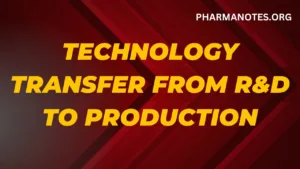Technology transfer from R&D to Production

Technology transfer from R&D to Production
Technology transfer creates a bridge between R&D and Production as it helps in creating more efficient and safe medications
This is a systematic process with proper protocol which should be followed by both ends while a QA personnel should verify and maintain the documentation included in these protocols.
Development, transfer, production, and documentation are the phases of technology transfer.
Master Formula Card (MFC) – The Master Formula Card (MFC) serves as the cornerstone of technology transfer. It encapsulates every detail of a pharmaceutical product, from ingredients and quantities to manufacturing instructions. It’s akin to a recipe that must be followed precisely to ensure consistent product quality.
Includes product name along with its strength, generic name, MFC number, page number, effective date, shelf-life, and market.
Master Packing Card – The Master Packing Card outlines the packaging specifications for the pharmaceutical product. It includes information on packaging materials, labeling requirements, and storage conditions. Proper packaging is vital to maintain product integrity and safety.
Gives information about packaging type, material used for packaging, stability profile and shelf life of packaging.
Master Formula Record – The Master Formula Record is a comprehensive document that combines information from the MFC and Master Packing Card. It guides production personnel step by step, ensuring that each batch is manufactured according to the predefined standards.
Describes formulation order and manufacturing instructions. (Process order and environment conditions)
Specifications and Standard Test Procedures (STP’S) – To maintain consistent quality, specifications and Standard Test Procedures (STPs) are established. These define the quality parameters and the testing methods to be employed during production. Adhering to these standards is critical to ensuring the safety and efficacy of the final product.
Helps to know active ingredients and excipients profile, in-process parameters, product release specifications and finished product details
Roles and Responsibilities
A successful technology transfer involves various stakeholders, each with specific roles and responsibilities. From R&D scientists to production managers and quality control experts, effective communication and collaboration are essential.
GIVING SITE | RECEIVING SITE |
• Provide Latest Source documentation. | • Execute Protocol(analytical method) |
• Latest Specifications (Internal or registered) | • Qualified Facility and equipment or instrument |
• Provide process(technology) transfer | • Setup system |
• Protocol/report (analytical report method) | • Setup training program |
Success of Technology transfer
The success of technology transfer can be gauged by evaluating whether the final product meets predefined quality standards, is produced within budget, and is delivered on time. Continuous improvement and feedback loops play a vital role in enhancing this process.
It depends on
Communication – Open communication between all team members
- Direct communication between technical members
- Effective and timely communication with regulators
Sending and Receiving Unit
- Technology transfer is not a “one-way street”
- The sending unit and receiving unit must be equally involved in the process to ensure success
- Teamwork at all time
Checklist of Technology transfer
A well-structured checklist acts as a safety net, preventing crucial details from being overlooked during technology transfer. It includes key milestones, deadlines, and quality control checkpoints to ensure a smooth transition.
It consists of,
- Production master formula.
- Manufacturing and Dispensing instructions.
- Analytical methods.
- Cleaning instructions and previous cleaning validation.
- Active specifications and source.
- Primary packaging material specifications and source.
- Packaging instructions.
- Process deviations file, Analytical deviations file.
- Specimen manufacturing batch record
Technology transfer from R&D to Production FAQs
What is the primary goal of pharmaceutical technology transfer?
The primary goal is to seamlessly transition a pharmaceutical product from the research and development phase to the production phase while maintaining quality and consistency.
Why is the Master Formula Card (MFC) essential in technology transfer?
The MFC provides a detailed blueprint for production, ensuring that each batch of the product is consistent and meets quality standards.
What role do specifications and Standard Test Procedures (STPs) play in technology transfer?
STPs set quality benchmarks and define testing methods to ensure product safety and efficacy.
How can technology transfer success be measured?
Success is measured by assessing whether the final product meets quality standards, stays within budget, and is delivered on time.
What is the significance of a checklist in technology transfer?
A checklist acts as a safety net, preventing crucial details from being overlooked during the transfer process, thus ensuring a smooth transition.
For PDF Notes Click on the Download Button
